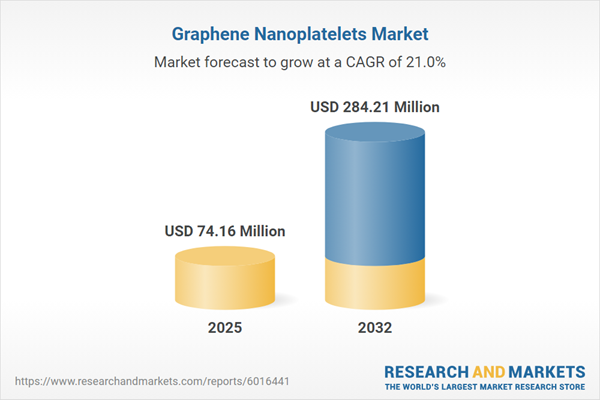Speak directly to the analyst to clarify any post sales queries you may have.
Graphene nanoplatelets are redefining material engineering standards across leading industries, enabling advancements in product quality, efficiency, and functionality. This market offers compelling opportunities for innovation-driven organizations seeking strategic growth in high-value applications ranging from aerospace to advanced energy systems.
Market Snapshot: Graphene Nanoplatelets Market Size and Growth
The graphene nanoplatelets market demonstrates strong momentum, having expanded from USD 61.88 million in 2024 to USD 74.16 million in 2025. With an anticipated CAGR of 20.99%, the sector is projected to reach USD 284.21 million by 2032. This robust trajectory highlights considerable investment interest, making the market increasingly relevant for stakeholders targeting high-growth, technology-enabled sectors.
Scope & Segmentation
- Type: Few Layer, Multi-Layer
- Form: Dispersion, Paste, Powder, Flake Form, Platelet Form
- Source: Natural Graphite, Synthetic Graphite
- Application: Composites, Conductive Inks & Coatings, Energy Storage, Lubricants & Greases, Sensors, Thermal Management
- End-User Industry: Aerospace & Defense, Automotive, Construction, Electronics, Energy & Utilities, Healthcare
- Regional Coverage: Americas (United States, Canada, Mexico, Brazil, Argentina, Chile, Colombia, Peru), Europe, Middle East & Africa (United Kingdom, Germany, France, Russia, Italy, Spain, Netherlands, Sweden, Poland, Switzerland, United Arab Emirates, Saudi Arabia, Qatar, Turkey, Israel, South Africa, Nigeria, Egypt, Kenya), Asia-Pacific (China, India, Japan, Australia, South Korea, Indonesia, Thailand, Malaysia, Singapore, Taiwan)
- Key Companies: ACS Material, American Elements, Angstron Materials, Cheap Tubes, CVD Equipment, Graphene 3D Lab, Graphene Square, Guangzhou Hongwu Material Technology, Haydale Graphene Industries, Merck KGaA, Nanografi Nano Teknoloji, Nanoinnova Technologies, Nanostructured & Amorphous Materials, NanoXplore, Raymor Industries, Shilpa Enterprises, Strem Chemicals, Techinstro, The Sixth Element Materials Technology, Thermo Fisher Scientific, Thomas Swan & Co., Tokyo Chemical Industry, Universal Matter GBR, Versarien, XG Sciences
Key Takeaways: Strategic Insights for Decision-Makers
- Growth is driven by technologies such as advanced chemical vapor deposition and exfoliation, which are raising quality standards and scalability potential.
- Collaborative initiatives between suppliers and end-users in aerospace, automotive, and energy storage sectors are reducing time to market through co-development.
- Ongoing optimization in synthesis and purification methods is supporting greater consistency and commercial adoption across diverse regions.
- Emerging regulatory guidelines are prompting improved safety, environmental stewardship, and supply chain accountability.
- Segment-specific innovations, such as customized dispersions and sustainable sourcing, help organizations address the specialized needs of different end-user industries.
Tariff Impact: United States Import Measures
The 2025 implementation of U.S. tariffs on select graphene nanoplatelet imports has reshaped the supply landscape and strategic sourcing. Suppliers have expanded or shifted manufacturing closer to target markets to control costs and currency fluctuations, while collaborative ventures aim to optimize purity and cost efficiency. Regional research initiatives are also being prioritized to bolster self-sufficiency and reduce reliance on foreign feedstock.
Methodology & Data Sources
This analysis combines primary interviews with key stakeholders and secondary research using peer-reviewed literature, patent databases, and industry reports. Triangulation of qualitative and quantitative data ensures the accuracy and practical relevance of strategic insights, with findings validated through expert review and pilot projects across multiple regions and industries.
Why This Report Matters
- Enables targeted product development by mapping emerging application opportunities and detailed segmentation.
- Supports procurement and supply chain resilience through assessment of market, regulatory, and tariff impacts worldwide.
- Guides leadership teams in shaping effective innovation and partnership strategies for sustainable competitive advantage.
Conclusion
The graphene nanoplatelets market is evolving rapidly, propelled by technological advances and collaborative ecosystems. Strategic alignment with regional dynamics and emerging applications is essential for organizations aiming to lead in this high-potential materials domain.
Additional Product Information:
- Purchase of this report includes 1 year online access with quarterly updates.
- This report can be updated on request. Please contact our Customer Experience team using the Ask a Question widget on our website.
Table of Contents
3. Executive Summary
4. Market Overview
7. Cumulative Impact of Artificial Intelligence 2025
Companies Mentioned
The companies profiled in this Graphene Nanoplatelets market report include:- ACS Material, LLC
- American Elements
- Angstron Materials Inc.
- Cheap Tubes Inc.
- CVD Equipment Corporation
- Graphene 3D Lab Inc.
- Graphene Square Inc.
- Guangzhou Hongwu Material Technology Co., Ltd.
- Haydale Graphene Industries PLC
- Merck KGaA
- Nanografi Nano Teknoloji Anonim Şirketi
- Nanoinnova Technologies S.L.
- Nanostructured & Amorphous Materials, Inc.
- NanoXplore Inc.
- Raymor Industries Inc.
- Shilpa Enterprises
- Strem Chemicals, Inc.
- Techinstro
- The Sixth Element Materials Technology Co., Ltd.
- Thermo Fisher Scientific Inc.
- Thomas Swan & Co. Ltd.
- Tokyo Chemical Industry Co., Ltd.
- Universal Matter GBR Ltd
- Versarien PLC
- XG Sciences, Inc.
Table Information
| Report Attribute | Details |
|---|---|
| No. of Pages | 185 |
| Published | November 2025 |
| Forecast Period | 2025 - 2032 |
| Estimated Market Value ( USD | $ 74.16 Million |
| Forecasted Market Value ( USD | $ 284.21 Million |
| Compound Annual Growth Rate | 20.9% |
| Regions Covered | Global |
| No. of Companies Mentioned | 26 |









